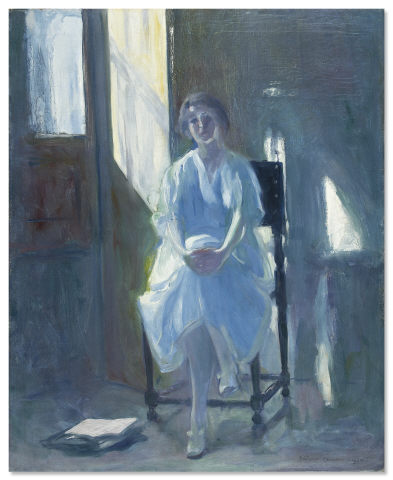
- 1920
- Canvas
- Oil
- Inv. 83P44
António Carneiro
Sinfonia azul
The psychological profile, and some of the more troubled aspects of the life of António Carneiro, have imbued the discourse surrounding his work with a tone that is sometimes hagiographical. Even when the laudatory component of this discourse is rejected, it ends up explaining the work through the artist’s biography, which does not always lead to a greater understanding of his painting. António Carneiro made several portraits throughout his career as a painter, many of which were commissioned, including works on paper in sanguine, pencil, or charcoal and oil paintings of friends, family members and respected members of society. Although recognised in his time by the people of Northern Portugal as a great portraitist, the renown which he subsequently achieved was largely due to his melancholic and disturbing landscapes, of which the remarkable uniqueness of his nocturnal paintings is particularly noteworthy. By comparison with his contemporary Columbano, his portraits are now less well considered. However, the paintings of his family and his closest friends, having been made without the need to satisfy the demands of a commission, are equally unique.
Sensitive to the most expressive and symbolic languages of fin de siècle painting, with which he came into contact while travelling around France, where he studied between 1897 and 1900, António Carneiro explored the possibility of approaching subjects by shaping them with his brush strokes, using mixtures and scrapings that rendered the preparatory drawing secondary or even dispensable. While carrying out this specifically pictorial investigation, he also never stopped working on drawing, in which he was proficient. When his drawing took on greater weight in his painting, however, it resulted in more academic pictures.
Sinfonia Azul (Blue Symphony) is one of those paintings which was produced in a domestic context and which used the painter’s daughter, Maria Josefina, as a model, although it might not be quite accurate to call it a portrait. The picture plays with the contrast between the interior darkness and the white morning light that enters through the window on the left, enveloping the door and projecting reflections onto the wall, the open book on the floor, and the dress and body of the seated young woman. The gradation of blacks, greys, blue- -greys and whites creates the blue atmosphere to which the title refers. Only some notes of yellow and some chestnut tones are allowed, transforming the image into a welcoming vision and countering the coldness of the other colours used. The face emerges from the dim light only as a result of the illumination created by brief pink brush strokes that outline, but do not reveal, the expression.
It is the light, whose reflections skip between the folds of the dress and the model’s bare arms and face, revealing the presence of the female figure, which gives full rein to the musical metaphor. The title completes the work in as far as it enacts a poetical reading of the intimate and pacifying painted moment. The female body is therefore presented more as an element that helps to create this atmosphere than as the subject of a portrait.
Mariana Pinto dos Santos
Maio de 2010
| Type | Value | Unit | Section |
| Width | 63,5 | cm | |
| Height | 78,5 | cm |
| Type | signature |
| Type | date |
| Type | Acquisition |
| António Carneiro (1872-1930) - algumas pinturas e desenhos |
| CAMJAP/FCG |
| Curator: Alice Costa Guerra |
| 21 de Junho de 2005 a 8 de Janeiro de 2006 Galeria do Piso 01 do museu do CAM |
| Exposição de pinturas e desenhos. |
| Inauguração do CAM |
| CAM/FCG |
| Curator: A definir |
| 20 de Julho de 1983 Lisboa, Centro de Arte Moderna/ FCG |
| 20 de Julho 1983. |
| Pintura Portuguesa - Século XX |
| Câmara Municipal de Coimbra |
| Curator: Telo Morais |
| 6 de Dezembro de 2001 a 27 de Janeiro de 2002 Casa Municipal da Cultura, Coimbra |
| Exposição que pretendeu retratar a produção de alguns pos pintores mais relevantes do século XX. |